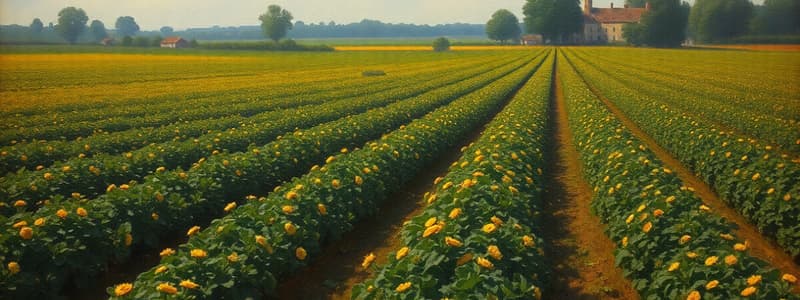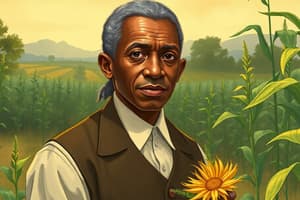Podcast
Questions and Answers
What was the main crop in the South during the late 19th century, before George Washington Carver's agricultural innovations?
What was the main crop in the South during the late 19th century, before George Washington Carver's agricultural innovations?
- Soybeans
- Cotton (correct)
- Sweet Potatoes
- Peanuts
Which of the following best describes the significance of George Washington Carver's testimony before the US House of Representatives in 1921?
Which of the following best describes the significance of George Washington Carver's testimony before the US House of Representatives in 1921?
- It secured federal funding for Carver's research programs at the Tuskegee Institute, ensuring their long-term sustainability.
- It formally established the peanut as a protected agricultural commodity under federal law, ensuring price stability for farmers.
- It marked a pivotal moment in advocating for crop diversification and the economic empowerment of peanut farmers, leading to newfound respect. (correct)
- It led to the immediate passage of legislation mandating crop rotation practices nationwide.
What overarching principle guided George Washington Carver's work at the Tuskegee Institute?
What overarching principle guided George Washington Carver's work at the Tuskegee Institute?
- Maximizing crop yields through the application of advanced chemical fertilizers.
- Promoting sustainable farming methods and self-sufficiency among formerly enslaved populations. (correct)
- Developing large-scale agricultural enterprises to compete with Northern industrial farms.
- Lobbying for federal subsidies to support the price of cotton and other Southern crops.
Beyond his agricultural research, what broader impact did George Washington Carver have on American society?
Beyond his agricultural research, what broader impact did George Washington Carver have on American society?
What was the primary purpose of George Washington Carver developing hundreds of uses for crops like peanuts and sweet potatoes?
What was the primary purpose of George Washington Carver developing hundreds of uses for crops like peanuts and sweet potatoes?
Flashcards
Who was George Washington Carver?
Who was George Washington Carver?
Agricultural scientist who innovated soil improvement and crop diversification.
Carver's educational milestone?
Carver's educational milestone?
First African American to enroll at Iowa State Agricultural College, earning a degree in 1894.
Carver's product count?
Carver's product count?
Over 400 marketable products from crops like peanuts and sweet potatoes.
Carver's solution for the South?
Carver's solution for the South?
Signup and view all the flashcards
Carver's role at Tuskegee?
Carver's role at Tuskegee?
Signup and view all the flashcards
Study Notes
- George Washington Carver was an African American agricultural scientist and experimenter.
- He helped restore the economy in the southern US.
- Carver used innovative scientific methods of soil improvement and crop cultivation.
- He developed commercially viable products from crops grown instead of cotton.
- Carver was born a slave on a Missouri plantation.
- He pursued an education following the abolition of slavery in 1865.
- He earned a master's degree in agriculture in 1896.
- Carver became director of agriculture at the Tuskegee Institute.
- Booker T. Washington ran the Tuskegee Institute.
- Carver devoted himself to improving southern agriculture.
Restoring the Economy
- In the late 19th century, the main crop in the South was cotton.
- Exclusive cultivation of cotton depleted nutrients from the soil, resulting in low yields.
- Carver encouraged farmers to grow peanuts, sweet potatoes, and soybeans.
- These crops were nitrogen-rich and helped restore the soil.
- He conducted research into derivative products from these crops.
- These crops were not commercially popular.
- Carver's work created over 400 marketable products, such as oils and dyes.
- His work boosted financial yields and helped the South become a key contributor to the US agricultural industry.
- Carver oversaw the Agriculture Department at Tuskegee Institute, Alabama, for 47 years.
- He taught ex-slaves about sustainable farming methods and techniques to become self-sufficient in his laboratory.
Milestones
- Carver became the first African American to enroll at Iowa State Agricultural College.
- He gained a degree in 1894.
- Carver invented 287 products derived from peanuts, as well as 118 from sweet potatoes from 1900 to 1920.
- He spoke for peanut farmers in front of the US House of Representatives in 1921.
- Subsequently, he received a standing ovation.
- Carver received multiple honors, including the Spingarn Medal in 1923.
- The award recognized his outstanding achievement.
Studying That Suits You
Use AI to generate personalized quizzes and flashcards to suit your learning preferences.
Description
This lesson explores the life and work of George Washington Carver, an African American agricultural scientist. It highlights his contributions to restoring the Southern US economy through innovative soil improvement and crop cultivation methods. Carver's work at the Tuskegee Institute played a vital role in diversifying agriculture.





